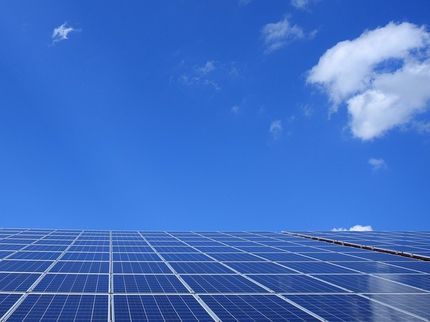Scientists produce transparent, light-harvesting material
Scientists at the U.S. Department of Energy's Los Alamos National Laboratory and Brookhaven National Laboratory have fabricated transparent thin films capable of absorbing light and generating electric charge over a relatively large area. The material, described in the journal chemistry of Materials, could be used in development of transparent solar panels.
"Potentially, with future refinement of this technology, windows in a home or office could generate solar power," said Hsing-Lin Wang, a co-corresponding author of the paper and a researcher in the Chemistry Division at Los Alamos.
The new material is a semiconducting polymer spiked with "fullerenes"—soccer-ball-shaped, cage-like molecules composed of 60 carbon atoms. When applied to a surface under carefully controlled conditions, the material self-assembles in a repeating pattern of micron-sized hexagonal-shaped cells resembling a honeycomb. Researchers created reproducible films of up to several square millimeters in area.
The material is largely transparent because the polymer chains pack together at the edges of the hexagons, remaining loosely packed and relatively thin across the centers. The densely packed edges strongly absorb light and could facilitate electrical conductivity, according to the researchers.
"Though such honeycomb-patterned thin films have previously been made using conventional polymers like polystyrene, this is the first report of such a material that blends semiconductors and fullerenes to absorb light and efficiently generate charge and charge separation," said lead scientist Mircea Cotlet, a physical chemist at Brookhaven's Center for Functional Nanomaterials (CFN).
Perfecting large-scale application of the material could enable a wide range of practical applications, such as energy-generating solar windows, or new types of optical displays.
The researchers fabricated the thin films by creating a flow of micron-sized (about 1/100th the width of a human hair) water droplets across a thin layer of the polymer-fullerene solution. The droplets assembled themselves into arrays within the polymer solution. Once the water evaporated, the scientists were left with thin films of polymer in a honeycomb pattern. The deposition method is cost effective and potentially scalable to industrial size.
Most read news
Other news from the department science

Get the chemical industry in your inbox
From now on, don't miss a thing: Our newsletter for the chemical industry, analytics, lab technology and process engineering brings you up to date every Tuesday and Thursday. The latest industry news, product highlights and innovations - compact and easy to understand in your inbox. Researched by us so you don't have to.


























































